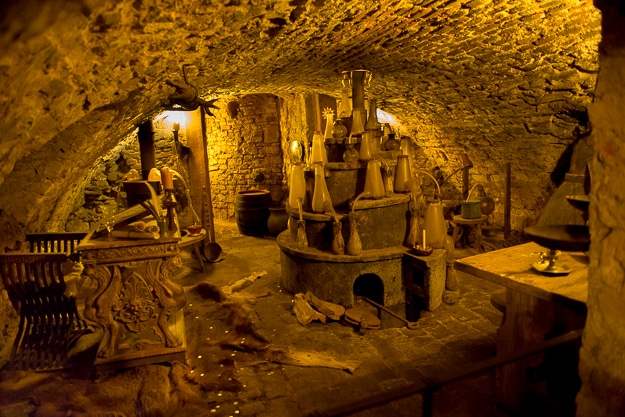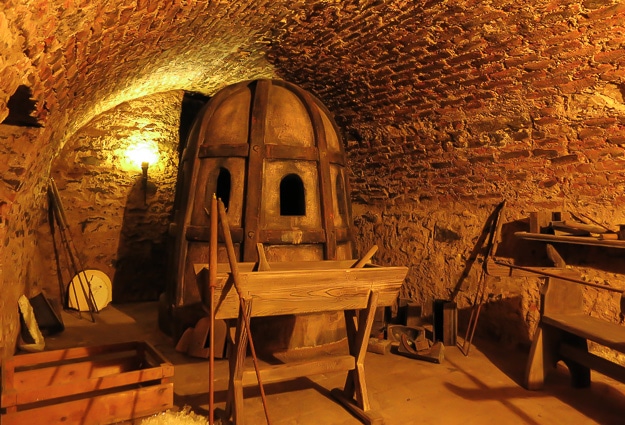Mephisto
Chemicus Diabolicus
  
Posts: 295
Registered: 24-8-2002
Location: Germany
Member Is Offline
Mood: swinging
|
|
German essay about 18th century's chemistry
When I did some time ago a research in a library, I found a very interesting essay about Johann Christian Berhardt. He was a German chemist in the
18th century. I felt the article in such a way exciting, that I scanned it in. I regret that it is only in German.
The essay describes how difficult it was to get chemicals like sulfuric acid or oleum for the 18th century's chemists. (No telephone to order it
from Merck   ). They did not only had to know suitable mines in which the minerals they required
were mined but also capable glass blowers, etc.. To that they had to travel through the country, which either wasn't simple then. ). They did not only had to know suitable mines in which the minerals they required
were mined but also capable glass blowers, etc.. To that they had to travel through the country, which either wasn't simple then.
I like the essay, because there are parallels to today, since many chemicals are watched or forbidden and had to be made by interested home-chemists.
It also shows, that engaged chemists are able to synthesize everything what they want by themselves. Berhardt even managed it to synthesize ether from
alcohol and his sulfuric acid (he was chemist and doctor).
I hope you enjoy this essay like I did. You can find it on the ftp in the PDF-articles folder:
Priesner, Claus - Johann Christian Berhardt und die Vitriolsäure - by Mephisto.pdf
Have fun!
[Edited on 21-3-2004 by Mephisto]
|
|
|
Mr. Rogers
Hazard to Others
  
Posts: 184
Registered: 30-10-2017
Location: Ammonia Avenue
Member Is Offline
Mood: No Mood
|
|
I was reading a thread here recently regarding distilling H2SO4 using an open flame, with no clear solution provided except for suggestions about
quartz flasks and heating mantles and digital controllers and all kinds of modern stuff.
We simply don't have the ceramic labware available that was common several hundred years ago and this would have been a very routine and obvious thing
to do back then. A chemist from that time would not have thought twice about this.
|
|
|
wildfyr
Harmless

Posts: 25
Registered: 23-6-2018
Member Is Offline
|
|
Doesn't ceramic glassware like that have a frightening tendency to crack open and spill its contents (like hot sulfuric acid!) all over your lab?
|
|
|
Mr. Rogers
Hazard to Others
  
Posts: 184
Registered: 30-10-2017
Location: Ammonia Avenue
Member Is Offline
Mood: No Mood
|
|
No. Ceramics can withstands much higher temperatures than glass. It's why crucibles, performance brake parts, kiln linings, etc. are made of
ceramic. Glass has many other advantages which is why it's widely used in labs. For temperatures, ceramics and carbon compositions are king. I
think zirconium crucibles are used to work with Iridium and artificial gemstones, for example.
[Edited on 20-9-2018 by Mr. Rogers]
|
|
|
Deathunter88
National Hazard
   
Posts: 519
Registered: 20-2-2015
Location: Beijing, China
Member Is Offline
Mood: No Mood
|
|
Quote: Originally posted by DemiPeters  | | Hey, it`s very interesting theme for an essay, I wrote my own using the site https://paperleaf.ca/tok-essay/ where i took a lot of useful information, checked his text on plagiarism and read articles from other people, or
those who also wrote essays, a good enough site for study) |
Nice try there, not going to fool us though.
|
|
|
Mr. Rogers
Hazard to Others
  
Posts: 184
Registered: 30-10-2017
Location: Ammonia Avenue
Member Is Offline
Mood: No Mood
|
|
This picture is from a laboratory discovered underneath a street in Prague. This is older than the 18th century but the distillation of high boiling
point material would have been performed in much the same way. The furnace the ceramic vessels are being heated on is stepped because there was no
way of accurately measuring or regulating temperature at the time.
And they DID have glass and used it in the lab. The second picture is of a furnace used for glass working.


[Edited on 20-9-2018 by Mr. Rogers]
|
|
|
macckone
Dispenser of practical lab wisdom
    
Posts: 2168
Registered: 1-3-2013
Location: Over a mile high
Member Is Offline
Mood: Electrical
|
|
Most chemists of the time apparently knew how to make basic pottery and their own retorts which are actually rather simple items. These items were
not leak proof and making oil of vitrol (sulfuric acid) had warnings about fumes and doing your work in clear air, ie. outside.
Having said that, some items like the best crucibles were made in specific locations and were reputed to be almost immune to thermal shock. Today we
know that those were ceramics high in alumina with large amounts of mullite which is formed when high alumina ceramics are heated leaving a
interlocking crystalline structure that is almost immune to thermal shock.
Perhaps we should open a sub-forum on materials and material science since ceramics, metallurgy and such come up quite often. Many existing threads
would be well suited to such a forum.
|
|
|
Mr. Rogers
Hazard to Others
  
Posts: 184
Registered: 30-10-2017
Location: Ammonia Avenue
Member Is Offline
Mood: No Mood
|
|
Quote: Originally posted by macckone  |
Perhaps we should open a sub-forum on materials and material science since ceramics, metallurgy and such come up quite often. Many existing threads
would be well suited to such a forum. |
+1. Even archaic chemistry. There's obvious modern utility to something like a ceramic retort in the production of sulfuric acid. We take this for
granted now that it's produced industrially and we just buy it.
[Edited on 20-9-2018 by Mr. Rogers]
|
|
|
JJay
International Hazard
    
Posts: 3440
Registered: 15-10-2015
Member Is Offline
|
|
I was under the impression that the alchemists used lead retorts for sulfuric acid.
|
|
|